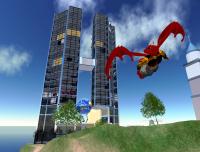

Copyright 2005, Linden Research, Inc. All Rights Reserved.
At the >play Digital Media conference in Berkeley there were separate panels to choose. I followed the video game people – something I know nothing about. It was fascinating. And as it turns out there were things happening in that world that were relevant to our communities.
You may know all about this but the industry breaks down so that about 75% of the game playing is casual (console or web-based, etc.) and the rest is MMOG (Massively Multi-player Online Games). For instance, one that’s been around for awhile called World of Warcraft has about 2M playing subscribers. Sony’s big game is Everquest Live. These are role-playing games where you take on a character, go on quests, and so forth along the way you acquire powers, objects that confer power or strength or wealth. It turns out that a huge secondary market has developed for these objects acquired during play. Players are selling them to other players in various venues including auction-like sites operated both by the game creators and independent operators. The panel‘s moderator suggested that:
“…this secondary market for stuff stored on people’s hard drives is between $100-200M per year in the US.”
Most remarkable to me was a site designed to optimize this commerce in virtual space called Second Life. If you don’t know this site please check it out.
Essentially the operators of this virtual world give you a plot of land and let you take up residence – you have a second life there and can build a home, business, meet others, play games, explore, etc. There is no game per se. And as you live your second life you can purchase the necessary life goods – clothing, jewelry, weaponry, and so on. The economy of this world is pegged to the US dollar and there’s a separate currency exchange. Residents of this world have built up businesses, hired others to be workers, and earn enough money to have no other job in the physical world. They create and sell virtual goods to fund their physical world. About $3M a month changes hands in this virtual world.
My point is these virtual goods are just digital objects. The digital objects have real monetary value associated with them, the intellectual property belongs to the player, and the Second Life operator specifically disclaims responsibility for them in the click through license agreement.
However, one of the other panelists, if I understood her correctly, remarked that the Chinese government has asserted a specific ownership formulation – the player owns the IP and the site operator is responsible for maintaining it. This interests me – if such a formulation were to happen here then we would suddenly have another industry that would have to take long-term preservation of digital objects very seriously. Another panelist confirmed this saying it would be in their interests and they are already investing in open formats and interchange formats (probably to support the sale of goods manufactured in Second Life to players in the World of Warcraft).
Jim coordinated the OCLC Research office in San Mateo, CA, focusing on relationships with research libraries and work that renovates the library value proposition in the current information environment. He retired in 2016.



